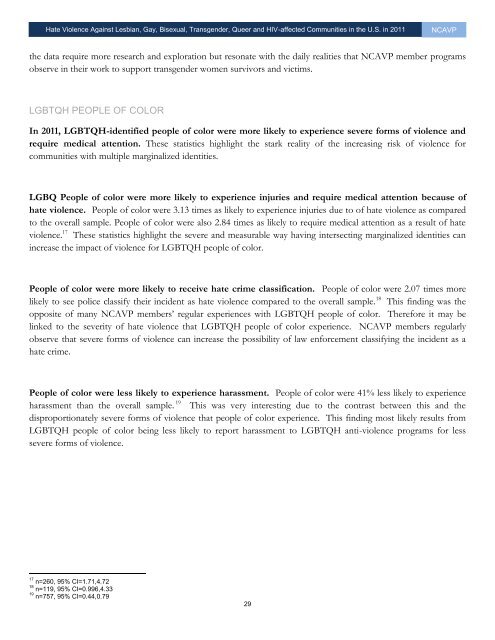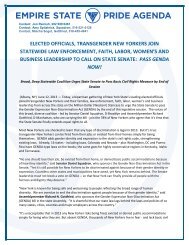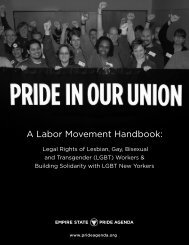<strong>Hate</strong> <strong>Violence</strong> Against <strong>Lesbian</strong>, <strong>Gay</strong>, <strong>Bisexual</strong>, Transgender, Queer and HIV-affected Communities in <strong>the</strong> U.S. in 2011NC<strong>AVP</strong>MOST IMPACTED IDENTITIESNC<strong>AVP</strong>’s person-level data allows us to highlight <strong>the</strong> identities that are most impacted by different types of hateviolence. Similar to findings for 2010, this year’s data suggests that people of color, transgender people, andtransgender people of color experience more severe and deadly forms of violence while simultaneously having lessaccess to anti-violence services and support. Transgender people of color represent a disproportionate amount ofreports of anti-LGBTQH violence because of unique intersections of identities and experiences of violence. Thedata for 2011 also highlights <strong>the</strong> specific ways in which people under <strong>the</strong> age of 30 are disproportionately affectedby sexual, physical, and police violence. The person-level findings below help to describe <strong>the</strong> ways in which <strong>the</strong>seidentities are specifically impacted by hate violence to assist policymakers and practitioners to craft specificprograms, policies, and laws to address this violence.Transgender communities: Transgender people are more at risk for severe violence but less likely toreceive law enforcement assistance; transgender women are particularly at risk.Transgender people were more likely to experience severe forms of violence and discrimination. Thebreadth and severity of violence reported by transgender people in 2011 highlights <strong>the</strong> specific vulnerability oftransgender communities, particularly in contrast to <strong>the</strong> overall sample. Transgender people were 1.74 times as likelyto experience discrimination compared to non-transgender people. 12 Transgender people were also 1.58 times aslikely to experience injuries because of hate violence. 13 Transgender people were 1.76 times as likely to requiremedical attention due to hate violence as compared to <strong>the</strong> overall sample. 14 These statistics highlight a crucial issuethat transgender people are disproportionately impacted by severe forms of violence and discrimination.Transphobic discrimination can be a barrier to accessing law enforcement assistance and medical assistance. Thisbarrier places transgender survivors and victims at a critical intersection between severe forms of violence anddecreased access to support. NC<strong>AVP</strong> needs to fur<strong>the</strong>r examine <strong>the</strong>se dynamics in addition to researching specificprograms to address <strong>the</strong> severity of anti-transgender violence.Transgender people were less likely to receive hate crime classification from police and more likely toexperience police violence. Transgender people were 45% less likely to see police classify <strong>the</strong>ir incident as hateviolence compared to non-transgender people. 15 Transgender people were also 1.67 times as likely to experiencepolice violence compared to non-transgender people. 16 Transphobia among law enforcement, whe<strong>the</strong>r it impacts<strong>the</strong> investigation of a transphobic hate crime, or is a motivator in police violence <strong>against</strong> transgender people is acritical issue for ensuring <strong>the</strong> safety for <strong>the</strong>se communities.Transgender women were more likely to experience harassment and sexual violence. NC<strong>AVP</strong>’s data alsosuggests that transgender women are more likely to experience harassment and sexual violence. These <strong>the</strong>mes in12 n=911, 95% CI=1.22,2.4613 n=327, 95% CI=0.85,2.9214 n=313, 95% CI=0.94,3.2715 n=148, 95% CI=0.19,1.6116 n=785, 95% CI=1.10,2.5428
<strong>Hate</strong> <strong>Violence</strong> Against <strong>Lesbian</strong>, <strong>Gay</strong>, <strong>Bisexual</strong>, Transgender, Queer and HIV-affected Communities in <strong>the</strong> U.S. in 2011NC<strong>AVP</strong><strong>the</strong> data require more research and exploration but resonate with <strong>the</strong> daily realities that NC<strong>AVP</strong> member programsobserve in <strong>the</strong>ir work to support transgender women survivors and victims.LGBTQH PEOPLE OF COLORIn 2011, LGBTQH-identified people of color were more likely to experience severe forms of violence andrequire medical attention. These statistics highlight <strong>the</strong> stark reality of <strong>the</strong> increasing risk of violence forcommunities with multiple marginalized identities.LGBQ People of color were more likely to experience injuries and require medical attention because ofhate violence. People of color were 3.13 times as likely to experience injuries due to of hate violence as comparedto <strong>the</strong> overall sample. People of color were also 2.84 times as likely to require medical attention as a result of hateviolence. 17 These statistics highlight <strong>the</strong> severe and measurable way having intersecting marginalized identities canincrease <strong>the</strong> impact of violence for LGBTQH people of color.People of color were more likely to receive hate crime classification. People of color were 2.07 times morelikely to see police classify <strong>the</strong>ir incident as hate violence compared to <strong>the</strong> overall sample. 18 This finding was <strong>the</strong>opposite of many NC<strong>AVP</strong> members’ regular experiences with LGBTQH people of color. Therefore it may belinked to <strong>the</strong> severity of hate violence that LGBTQH people of color experience. NC<strong>AVP</strong> members regularlyobserve that severe forms of violence can increase <strong>the</strong> possibility of law enforcement classifying <strong>the</strong> incident as ahate crime.People of color were less likely to experience harassment. People of color were 41% less likely to experienceharassment than <strong>the</strong> overall sample. 19 This was very interesting due to <strong>the</strong> contrast between this and <strong>the</strong>disproportionately severe forms of violence that people of color experience. This finding most likely results fromLGBTQH people of color being less likely to report harassment to LGBTQH anti-violence programs for lesssevere forms of violence.17 n=260, 95% CI=1.71,4.7218 n=119, 95% CI=0.996,4.3319 n=757, 95% CI=0.44,0.7929
- Page 1 and 2: Hate ViolenceAgainst Lesbian, Gay,B
- Page 3: Hate Violence Against Lesbian, Gay,
- Page 6 and 7: Hate Violence Against Lesbian, Gay,
- Page 8 and 9: Hate Violence Against Lesbian, Gay,
- Page 10 and 11: Hate Violence Against Lesbian, Gay,
- Page 12 and 13: Hate Violence Against Lesbian, Gay,
- Page 14 and 15: Hate Violence Against Lesbian, Gay,
- Page 16 and 17: Hate Violence Against Lesbian, Gay,
- Page 18 and 19: Hate Violence Against Lesbian, Gay,
- Page 20 and 21: Hate Violence Against Lesbian, Gay,
- Page 22 and 23: Hate Violence Against Lesbian, Gay,
- Page 24 and 25: Hate Violence Against Lesbian, Gay,
- Page 26 and 27: Hate Violence Against Lesbian, Gay,
- Page 30 and 31: Hate Violence Against Lesbian, Gay,
- Page 32 and 33: Hate Violence Against Lesbian, Gay,
- Page 34 and 35: Hate Violence Against Lesbian, Gay,
- Page 36 and 37: Hate Violence Against Lesbian, Gay,
- Page 39 and 40: Hate Violence Against Lesbian, Gay,
- Page 41 and 42: Hate Violence Against Lesbian, Gay,
- Page 43 and 44: Hate Violence Against Lesbian, Gay,
- Page 45 and 46: Hate Violence Against Lesbian, Gay,
- Page 47 and 48: Hate Violence Against Lesbian, Gay,
- Page 49 and 50: Hate Violence Against Lesbian, Gay,
- Page 51 and 52: Hate Violence Against Lesbian, Gay,
- Page 53 and 54: Hate Violence Against Lesbian, Gay,
- Page 55 and 56: Hate Violence Against Lesbian, Gay,
- Page 57 and 58: Hate Violence Against Lesbian, Gay,
- Page 59 and 60: Hate Violence Against Lesbian, Gay,
- Page 61 and 62: Hate Violence Against Lesbian, Gay,
- Page 63 and 64: Hate Violence Against Lesbian, Gay,
- Page 65 and 66: Hate Violence Against Lesbian, Gay,
- Page 67 and 68: Hate Violence Against Lesbian, Gay,
- Page 69 and 70: Hate Violence Against Lesbian, Gay,
- Page 71 and 72: Hate Violence Against Lesbian, Gay,
- Page 73 and 74: Hate Violence Against Lesbian, Gay,
- Page 75 and 76: Hate Violence Against Lesbian, Gay,
- Page 77 and 78: Hate Violence Against Lesbian, Gay,
- Page 79 and 80:
Hate Violence Against Lesbian, Gay,
- Page 81 and 82:
Hate Violence Against Lesbian, Gay,
- Page 83 and 84:
Hate Violence Against Lesbian, Gay,
- Page 85 and 86:
Hate Violence Against Lesbian, Gay,
- Page 87 and 88:
Hate Violence Against Lesbian, Gay,
- Page 89 and 90:
Hate Violence Against Lesbian, Gay,
- Page 91 and 92:
Hate Violence Against Lesbian, Gay,
- Page 93 and 94:
Hate Violence Against Lesbian, Gay,
- Page 95 and 96:
Hate Violence Against Lesbian, Gay,
- Page 97 and 98:
Hate Violence Against Lesbian, Gay,
- Page 99 and 100:
National Coalitionof Anti-Violence
- Page 101 and 102:
Hate Violence against Lesbian, Gay,
- Page 103:
Hate Violence against Lesbian, Gay,




